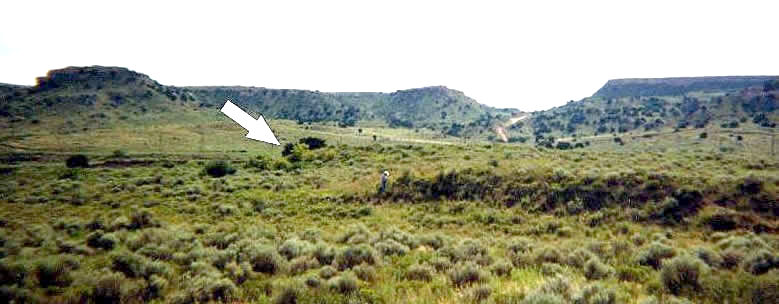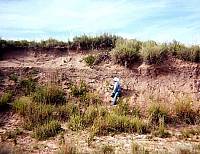
Erickson takes a close look at the freshly exposed evidence
on the discovery day. The burned layer marking the house floor
is even with his hat. To his left is the red stain of the
house's fire pit. Photo by Doug Boyd.
Click images to enlarge
|
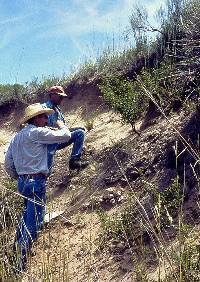
The Two Dougs looking intently at the newly-discovered
buried pithouse, later dubbed Hank's house after rancher and
writer John Erickson's world-renowned fictional character,
Hank the Cowdog. Photo by Kris Erickson.
|
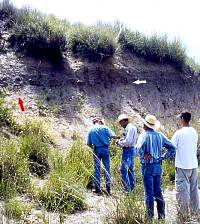
Cutbank where Hank's house was discovered
on July 16, 2000. The white arrow points to the layer of burned
debris on the pithouse floor. The red arrow points to the
hearth in the center of the house, which, by sheer accident,
was cut precisely in half by erosion. John Erickson and son,
Mark, look on as the Two Dougs juggle samples. Photo by Kris
Erickson. |
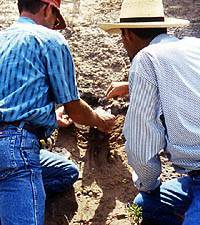
Boyd and Wilkens collect a sample of charcoal
from the firepit to be used for radiocarbon dating to ascertain
the age of Hank's house. Photo by Kris Erickson. |

Hank the Cowdog, for whom the site and
pithouse are named, is the "head of ranch security" in the
much-read series of children's books written by John Erickson.
Illustration by Gary Rinker. |
|
It all started with a horseback ride in the spring
of 2000. Rancher John Erickson was out tending cattle when he came
across an interesting find. By this time, Erickson knew much about
the prehistoric people who had lived in the area where his ranch
now stood. He had been bitten by the archeology bug and had trained
his keen eyes to search for flint chips, bone fragments, burned
caliche rocks, and other clues of long-forgotten peoples. On this
particular occasion while riding along a creek bottom, he noticed
some black stains buried in the edge of the cutbank. He instinctively
knew that it was probably charcoal, or burned wood, and that it
might be part of a prehistoric site. He stopped for a moment to
investigate. Convinced it was probably worth a closer look at some
later time, Erickson went on searching for his cattle but filed
away the location of this new find in his mind.
A few months later, the "Two Dougs" (Wilkens
and Boyd) visited the ranch and Erickson showed us some of the archeological
sites he had found. Prior to this trip, Wilkens and Erickson had
spent many days recording and investigating sites on the ranch,
and Boyd had visited on one other occasion. We knew that there were
lots of interesting archeological sites on the ranch, but all three
of us were surprised and excited by what we discovered on this particular
day—July 16, 2000.
Erickson took us back to the creek where he had found
the charcoal. It looked interesting, so we began looking closer.
Creek cutbanks have a way of hiding buried things, so it took us
a few minutes to carefully trowel away the thin layer of rain-washed
soil that had already covered the charred patch Erickson had seen
before. Once we got a good look at the freshly exposed strata, the
extent of the find became obvious. A horizontal line of charcoal
could be traced for nearly 20 ft (about 6 meters) along the cutbank.
There were masses of burned branches and smaller twigs, along with
burned clay lumps (called daub) that had impressions of sticks in
them. In the center and just below the charcoal line was a bowl-shaped
depression outlined by thick, bright orange burned clay and filled
with gray ash and brown sand. The signs were unmistakable—it
was the floor of a pithouse and a firepit buried by layers of sand
laid down by the stream. Because there was so much charcoal and
daub, we speculated that the upper portion of the house had burned,
and the wood and clay from the roof had collapsed onto the floor.
Because most prehistoric houses in this area have a firepit or hearth
right in the center, we realized the creek had sliced this house
exactly in two.
Such finds are fairly rare, even for archeologists—in
just a few minutes we had exposed a prehistoric house sliced in
half as neatly as any archeological excavation could have done.
In our excitement, the questions flowed quickly: How old was this
house? Was it part of a village? What other surprises did the cutbank
hold?
We spent more time looking along the cutbank near
the house and found flint flakes and some sherds of cordmarked pottery.
The pottery told us that the house probably belonged to the Plains
Woodland or Plains Village peoples who inhabited this stretch of
the Canadian River valley between about A.D. 200 and 1450. Because
the sherds were fairly thick—thicker than the typical late
Borger Cordmarked variety—we suspected that it could be from
the Plains Woodland or early Plains Village periods.
The thrill of discovery continued as we three explorers
found a storage pit, exposed in the same cutbank about 50 feet (15
meters) away from the buried pithouse. The pit, dug into the ground
by prehistoric people, was a typical "bell-shaped" storage
pit like those used by many Southern Plains villagers. These pits
were circular on the top, and, like the Liberty Bell, expanded out
into a flat bottom.
The excitement wasn't over just yet. As we continued
our search farther away from the buried pithouse, we found more
evidence of prehistoric occupations. Flint flakes, bone fragments,
and pottery sherds were strewn along the cutbank of the meandering
stream channel as far as 650 feet (nearly 200 meters) to the west
of the buried house. More artifacts and dark stains in the ranch
road marked locations of other probable buried houses some 980 feet
(nearly 300 meters) to the south. Most of the intervening area had
a thick layer of sand dunes that completely covered the alluvial
terrace, but these finds indicated that buried cultural deposits
could be present over an area of 645,500 square feet (60,000 square
meters) or over 13 football fields or more!
We returned to Erickson's house for lunch and reported
the interesting finds to John's wife, Kris, and son, Mark. The whole
group of us then returned to the site and spent much of the afternoon
recording archeological details about the new site. As we carefully
excavated and bagged a small sample of charcoal from the burned
pithouse for radiocarbon dating, we speculated on the possible age
of the buried house. Later in the evening as the sun began to sink
below the canyon rim at the ranch house, everyone sat on the Erickson's
front porch to discuss the day's events. The significance of the
day's finds was beginning to sink in.
John's sharp eyes and inquisitive mind had led to
the discovery of a burned prehistoric pithouse, a relatively rare
occurrence. Even more important, the discovery included a whole
village site, apparently a large one, in an area where few such
sites were known. Only a tiny portion of the site was visible, but
it was clear that many other houses and other evidence of prehistoric
life remain buried there. Such discoveries do not happen every day.
Everything considered, July 16, 2000, was an exciting day for Panhandle
archeology. I suggested that this new site be called Hank's site
in honor of Hank the Cowdog. The name stuck, and from that point
on, everyone referred to the buried pithouse as Hank's house.
|
|
In just a few minutes we had exposed a prehistoric house
sliced in half as neatly as any archeological excavation could
have done. In our excitement, the questions flowed quickly:
How old was this house? Was it part of a village? What other
surprises did the cutbank hold?
|
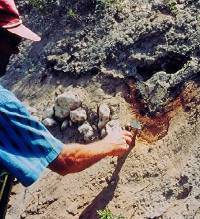
Boyd uses his trowel to expose the pithouse's
distinctive central hearth or firepit. The orange-colored
oxidized earth is the "thermal rind" of the firepit and was
caused by prolonged intense burning (and iron present in the
soil). The cluster of rounded caliche cobbles to the left
and beneath the hearth is a natural gravel deposit left by
the stream and is completely unrelated to the house. Photo
by Kris Erickson.
|
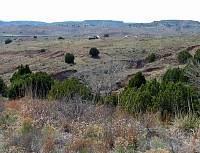
The small unnamed stream along which Hank's
site lies originates in the rugged upper part of the West
Pasture. The green band of trees in the foreground of this
photo are watered by Indian Springs. The tent and vehicles
visible in the background mark the location of the Indian
Springs site, where archeologist Brett Cruse directed test
excavations in 2002. Photo by Brett Cruse.
|
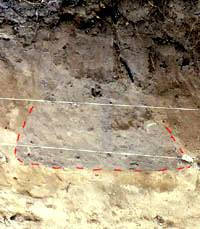
Photograph of the bell-shaped storage pit
(later called Pit 1). Exposed in the cutbank by creek erosion,
the fill inside this pit was slightly darker than the surrounding
sandy soil. The pit was probably used to store plants that
people harvested in the fall so they could have food during
the winter and early spring months. The bell shape of this
pit is typical of the subterranean storage pits used by many
Native American groups on the Great Plains. (Lower part of
pit is outlined in red dashes; click to see enlarged view
without dashes.) Photo by Doug Boyd.
|
|
